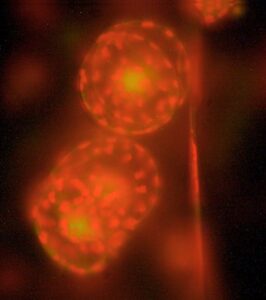
Centric diatoms from the Ross Sea Antarctica with red chlorophyll fluorescence visualized using epifluorescence microscopy. Photo by P. Tortell
Now available at the Ocean Best Practices platform (https://repository.oceanbestpractices.org/handle/11329/1585), this document produced by SCOR Working Group 156, ‘Active Chlorophyll Fluorescence for Autonomous Measurements of Global Marine Primary Productivity’ is focused on single turnover methods, which are most commonly used in phytoplankton research, while recognizing that other approaches, including Pulse Amplitude Modulation (PAM) fluorescence techniques, are also employed with macro-algae, corals and terrestrial plants.
The group was established in 2019, bringing together researchers and instrument manufacturers from 10 countries and 5 continents, with the goal of developing standards of best practice for the application of single turnover active chlorophyll fluorescence (ST-ChlF) to examine phytoplankton productivity.
Tortell, P.D. and Suggett, D.J. (eds) (2021) A User Guide for the Application of Single Turnover Active Chlorophyll Fluorescence for Phytoplankton Productivity Measurements. Version 1. Scientific Committee on Oceanic Research Working Group 156, 20pp. DOI: http://dx.doi.org/10.25607/OBP-1084